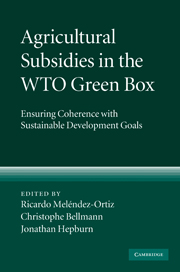Book contents
- Frontmatter
- Contents
- List of contributors
- Preface
- Acknowledgements
- List of abbreviations
- 1 Overview
- PART I The recent evolution of agricultural trade policy reform
- PART II The focus, extent and economic impact of green box subsidies
- 7 An analysis of EU, US and Japanese green box spending
- 8 Green box subsidies and trade-distorting support: is there a cumulative impact?
- 9 The distributional structure of green box subsidies in the European Union and France
- 10 The distributional structure of US green box subsidies
- PART III Green box subsidies and developing countries
- PART IV Green box subsidies and the environment
- PART V Looking forward: how can change take place?
- Appendix: Text of Annex 2 of the WTO Agreement on Agriculture (“the green box”)
- Index
- References
10 - The distributional structure of US green box subsidies
from PART II - The focus, extent and economic impact of green box subsidies
Published online by Cambridge University Press: 03 May 2010
- Frontmatter
- Contents
- List of contributors
- Preface
- Acknowledgements
- List of abbreviations
- 1 Overview
- PART I The recent evolution of agricultural trade policy reform
- PART II The focus, extent and economic impact of green box subsidies
- 7 An analysis of EU, US and Japanese green box spending
- 8 Green box subsidies and trade-distorting support: is there a cumulative impact?
- 9 The distributional structure of green box subsidies in the European Union and France
- 10 The distributional structure of US green box subsidies
- PART III Green box subsidies and developing countries
- PART IV Green box subsidies and the environment
- PART V Looking forward: how can change take place?
- Appendix: Text of Annex 2 of the WTO Agreement on Agriculture (“the green box”)
- Index
- References
Summary
Introduction
The objective of this chapter is to provide information on the distributional structure of US green box subsidies. The extent to which payments are made to farms of different sizes is provided as well as the importance of subsidy payments as a share of both farm and off-farm income. We will analyze the distributional structure of payments under different types of green box programs. The implications of this structure for the achievement of economic, social and environmental public policy goals are derived. Because payments tend to go to the largest farms, sustainable development objectives such as preserving the family farm and providing environmental services may be undermined. The chapter examines the extent to which the structure of green box subsidies distorts production and international trade. Finally, the chapter offers some suggestions for options to reform green box criteria that might support sustainable development goals in developed as well as developing countries.
Distributional structure of US green box payments
The evolution of overall US green box subsidies and its relation to the other “boxes” is given in Antón (this volume, chapter 7) and Matthews (2006). Our analysis focuses only on payments that can potentially be captured directly by producers. Hence, we exclude domestic food aid to consumers, the largest share of US green box expenditures. Table 10.1 summarizes the remaining categories of expenditures for the base period and for each year of the implementation period through 2005 (the last year for which the US notified the WTO of its domestic support).
- Type
- Chapter
- Information
- Agricultural Subsidies in the WTO Green BoxEnsuring Coherence with Sustainable Development Goals, pp. 304 - 326Publisher: Cambridge University PressPrint publication year: 2009

